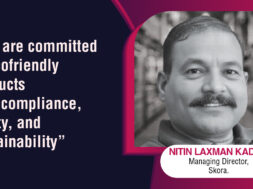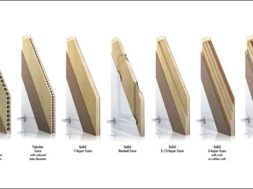
A fourth-generation architect Heather Dubbeldam, Principal Architect, Dubbeldam Architecture + Design speaks to Vikas Bhadra about her love for architecture, recent projects, achievements and her affinity for Indian architects.
“Good design, especially in architecture, ensures that the end user is considered throughout the process,” says Heather Dubbeldam, Principal Architect, Dubbeldam Architecture + Design, “it has the ability to influence and shape the quality of life for the inhabitant, so wellness, social and environmental sustainability, and beauty must be the foundation. A fourth-generation architect in the family Heather always felt that architecture has a transformative capability and was drawn to the profession at an early age. she started my career at KPMB Architects in Toronto, an award-winning internationally recognized architecture firm with a very high level of design rigour. This proved to be an amazing training ground and inspired her to start her own practice. “I’ve always been an advocate for architecture and the power of design to improve quality of life so that was one of the key reasons for the inception of Dubbeldam Architecture + Design.”
In its journey so far Dubbeldam has worked on different projects and won numerous accolades along the way. “Our firm has received over 50 awards for design excellence, practice and advocacy,” says Heather “One of our more significant awards was the Professional Prix de Rome in Architecture, which allowed us to conduct field research on the most sustainable design innovations for northern climates as seen in Scandinavia.”
In a timeline when Covid-19 has impacted the way we work and live, Heather believes it will reemphasize our connection with nature “I believe Covid will bring a reconnection with nature, wellness and with people, once it is considered ‘safe’ to reconnect. New emphasis will be placed on access to the outdoors, healthy air (improved air handling systems and natural ventilation strategies) and the democracy of light, especially in work environments.” Even though the pandemic has pulled the reins on the pace at which projects are being built, Team Dubbeldam is a busy lot “We have a mix of commercial, institutional, residential and cultural projects on the go currently and we’re excited about them all!,” says Heather “We have the luxury of only taking on work that interests us and align with our vision and values. One of our more interesting projects is an Arts and Community Centre in Rural Ontario Canada (about 3 hours drive West of Toronto and one hour east of Detroit USA) that will be one of the most sustainable projects we’ve ever done incorporating mass timber/CLT, geothermal, solar and wind. There are many different elements to the program of the building, in terms of arts and performing arts function, and the integration with the landscape and the community, and it has been a very rewarding project so far.”
Though Heather continues to work on different projects a research project for Sidewalk Labs in Toronto offered her a great deal of personal and professional gratification. “The research project for Sidewalk Labs in Toronto focused on flexible living, co-living and micro units for affordability. It was inspiring working with an organization who was pushing all the boundaries for innovation, in every aspect of architecture and urban design.” For an architect as also an interior design professional, it is essential to stay inspired and what better than to find it in the numerous festivals which are dedicated to architecture and design “We attend festivals to stay current, network and for inspiration for our work,” says Heather “Festivals bring people together and create opportunities for innovation and collaboration that may not happen otherwise. I’ve had the opportunity to meet some great architects at these events including Jeanne Gang of Studio Gang, Winka Dubbeldam of ArchiTectonics, and David Adjaye. In Canada there is the Interior Design Show (IDS) and the Royal Architectural Institute of Canada (RAIC) Festival of Architecture, That apart we also try to attend Salone Del Mobile held in the city of Milan in Italy and WAF (World Architecture Festival) for inspiration.”
In this present timeline it is necessary for an architect to ensure that his/her work responds to nature in a symbiotic way “Architects have a responsibility to design with sustainability in mind, both environmental and social sustainability, to ensure our projects are in sync with nature we employ biophilic design principals in our projects as much as possible. As such, we gravitate to natural materials and employ the use of natural light to best effect. We believe it is possible to design beautiful buildings that are also responsible and sustainable. The best examples of this are in Scandinavia, as they are leaders in social and environmental architecture.” An architect whose contemporary creations have brought her tremendous acclaim Heather points out contemporary architecture has a much better relationship with the urban environment, with more consideration toward the connection with the urban landscape and the way a building meets the ground plane as well as the consideration of landscaping. Contemporary architecture has also brought in what can be termed as ‘a uniformity of design across the globe’. “Yes, there is an emerging uniformity of design across the globe,” says Heather “With international architects working in different jurisdictions and with the proliferation of photographs of buildings on social media. However, the best architects design with a sense of the local place and inhabitants in mind and the resulting buildings are more contextual and sensitive to local building traditions and culture.”
Heather’s love for sustainable design have brought her close to Indian architects “I admire the work of Shimul Javeri Kadri (SJK Architects), who use the sun and the wind to craft environments that are ecologically sound and naturally beautiful. I also admire Sheila Sri Prakash whose focus is on environmentally and socioeconomically sustainable architecture. She is on a number of national and international advisory committees and her designs typically include connection to green spaces and natural light and the use of passive ventilation strategies for cooling.
As the conversation ends, Heather concludes “Architecture is perhaps much beyond form and function; the built form can have a profound effect on its users with intangible elements like the use of natural light and shadow to ‘sculpt’ the space. A beautiful, well-considered design can not only raise the spirit of its occupants and but it also brings an immense amount of joy and happiness in their lives”
6
Cookie Consent
We use cookies to personalize your experience. By continuing to visit this website you agree to our Terms & Conditions, Privacy Policy and Cookie Policy.









